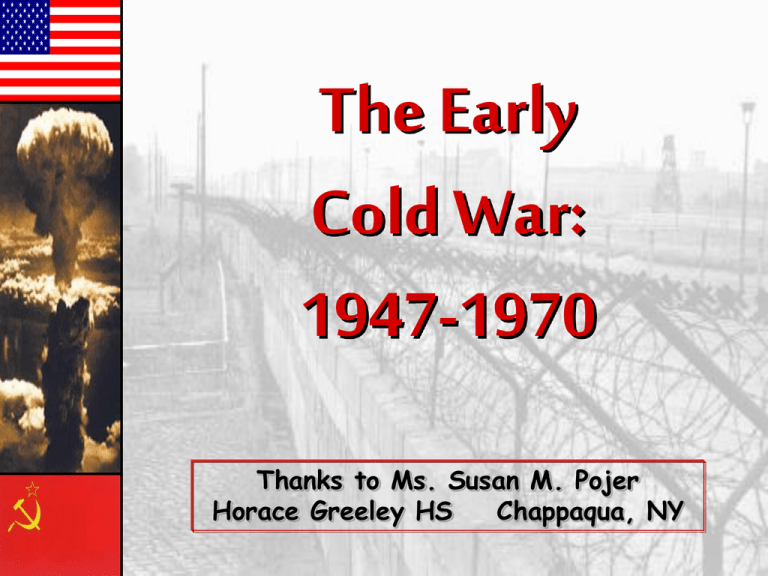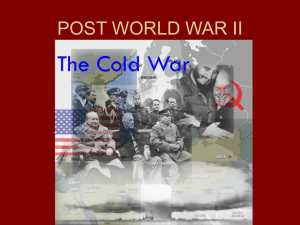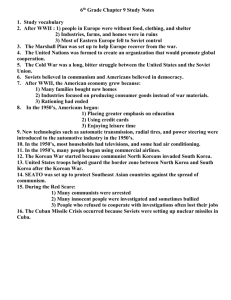Cold War
advertisement

The Early Cold War: 1947-1970 Thanks to Ms. Susan M. Pojer Horace Greeley HS Chappaqua, NY 1945 - 1991 Copy Down Vocab • Superpower – an extremely powerful and influential nation, both economically and militarily • Containment – U.S. policy to stop the spread of communism by creating alliances and helping weak countries • Cold War – the state of diplomatic hostility between the U.S. and Soviet Union • Proliferation – the growth or spread of something such as nuclear weapons • Communism –economic and political belief where everything should be owned by the public Copy Down Vocab • Arms Race – competition between countries to expand the amount of weapons they have • Détente – policy of reducing Cold War tension between the U.S. and SU • Democratization – the process of making a country into a democracy • Nonalignment – nations that remained neutral and did not pick a side in the Cold War • Nuclear Holocaust – annihilation of humanity by nuclear warfare Post-WWII Europe • EQ: How does Europe change after WWII and how does it recover? Post-War Europe • How is Europe after the war? – Devastated by war, 60 million dead (2/3 civilians) – Cities destroyed, famine, and disease • How are the people of Europe? – They are looking for new leadership – Desire stability and peace Europe’s Question: Who will countries look to for leadership? Emergence of Superpowers • Before WWII – There were several great powers: France, Great Britain, Germany, U.S., USSR, Japan • After WWII – United States and Soviet Union (winners of WWII) emerge as superpowers VS Europe is Divided • What happens? – By 1945, Europe is divided between the Soviets in the East and the Western Powers (U.S., GB, and France) in the West – Germany and Berlin are divided • Why does this happen? – Stalin takes over eastern countries for protection against the West. The Iron Curtain • Soviets kept the countries they freed from the Germans • Installed communist govts • No elections, no freedom • It was as if an “iron curtain” divided Europe American vs Soviet Goals U.S. Goals • Encourage democracy • Rebuild Europe to create stability and new markets • Reunite Germany • Stop the spread of communism Soviet Goals • Encourage communism • Control Eastern Europe for protection • Keep Germany divided Allies Become Enemies America’s Challenge • What is America’s challenge? – How to keep the Western European countries democratic and rebuild their economies • What does the U.S. decide to do? – U.S. will give money, aid, food, machines to countries in Europe – This was known as the Marshall Plan – Very successful in helping Europe recover Directions • Complete the Marshall Plan worksheet on the back of the graphic organizer • Answer all of the questions • Turn in when completed for a grade Post-War World: International Cooperation Essential Question • How were the efforts made after WWII at creating a lasting peace more successful than those after WWI? Quick Review of Post-WWI • Germany is severely punished • Creation of League of Nations – U.S. did not join so not powerful • Dictators and Aggression throughout Europe • WWII Begins Allies Debate Post-War World • Need to think beyond Europe • “The Big Three” meet at Yalta in 1945 to discuss post-war plans • The issues discussed: – Germany, reparations, and the formation of international organizations Thinking Internationally • The Allies agree that they need to change how the world works to avoid war, famine, atrocities, etc… • Instead, need to promote peace, security, stability, and tolerance How do we achieve this? • By creating international organizations where countries can cooperate and help one another United Nations • Think of it as a congress for countries around the world • Diplomacy first – talk out your issues before jumping into war • Promote peace and stability • 193 countries are members as of 2013 Security Council • This is the leadership branch of the UN • The permanent members of the Security Council have veto power – U.S., Russia, France, Great Britain, and China (winners of WWII) World Health Organization • Branch of the UN • Researches and fights off diseases • Promotes public health around the world World Bank • Goal: fight poverty and increase the standard of living • Provides loans and investments to countries – Schools, electricity, disease control International Monetary Fund • Purpose is to maintain economic cooperation and trade so not to repeat 1930s Depression • Give loans to countries Directions • Use the sheet (front and back) to answer the following questions on the back of your graphic organizer. • The first six questions go with the WWI & WWII Compare & Contrast • The next five questions go with the League of Nations vs UN sheet The Cold War: Strategy and Competition Essential Question • How did Cold War strategies and competition foster conflict? Containment (1947) • President Truman says the U.S. will follow a policy of containment – Contain communism – Use military alliances and economic aid to protect countries Berlin Blockade and Airlift (1948) • Soviets block Western Berlin so U.S. cannot send in supplies – Why? – Soviets want control of all Berlin • Berlin Airlift – Allies/U.S. fly food/supplies into Berlin for 11 months – Stalin backs down Soviets Get Atomic Bomb (1949) • Soviets test their first atomic bomb • U.S. no longer has atomic bomb advantage Formation of NATO (1949) • North Atlantic Treaty Organization is formed • Defensive Alliance against the Soviet Union Korean War (1950 – 1953) • North Korea (communists) invades South Korea • UN puts together force led by U.S. to push them back • Stalemate at 38th parallel • http://www.youtube.com/watch?v=PcmMtNOVORc • http://www.youtube.com/watch?v=0Uojhwx0k8A U.S. and Soviets Create H-Bomb (1952-1953) • Now it becomes an arms race as to who can develop the deadliest nuclear weapons Nuclear Weapons Soviets Launch Sputnik (1957) • Soviets launch satellite using ICBM (intercontinental ballistic missile) • Americans feel they are falling behind in space – Competition in space Cuban Revolution (1959) • Communists overthrow the American backed dictator in Cuba – Only ninety miles off the coast – U.S. starts plotting invasion Essential Question • How did Cold War strategies and competition foster conflict and communication? U-2 Incident (1960) • U.S. U-2 spy plane is shot down over the Soviet Union and pilot is captured Bay of Pigs (1961) • President Kennedy allows CIA and U.S. military to back Cuban-refugee invasion to overthrow Castro (dictator backed by the Soviets). • Epic fail • Soviets feel they need to protect Cuba • “There is an old saying that victory has a thousand fathers, but defeat is an orphan.” ~President Kennedy Cuban Missile Crisis (1962) • The closest the world came to nuclear war • http://www.youtube.com/watch?v=Oj_19REPJ7Q • Soviets shipped nuclear weapons to Cuba • http://www.youtube.com/watch?v=W50RNAbmy3M • U.S. finds out and “quarantines” the island (blockade) from Soviets • Soviets back down as Kennedy works out an agreement http://www. youtube.co m/watch?v =Ig8UdfQK XSY Kennedy-Khrushchev Connection1962 • Kennedy and Khrushchev create a direct telephone link to one another • They begin a semi-friendly dialogue Partial Test Ban Treaty (1963) • Signed by President Kennedy and Khrushchev • Banned the testing of nuclear bombs in the atmosphere, water, or space • Work on disarmament Vietnam War (1965-1973) • Kennedy had planned on withdrawing troops in 1964 • He was assassinated in Nov 1963 • Lyndon Johnson assumes office and pledges full support to South Vietnam Cuban Missile Crisis Letter Analysis • Read the three letters from Khrushchev, Bobby Kennedy, and John F. Kennedy • Answer the analysis questions to understand the deals they made Vietnam War • Essential Question: How are people affected by war and how do they respond to it? Background • Divided in two after WWII • Communists in North and noncommunists in South – South Vietnam was ruled by American backed dictator – Communists oppose him Why bother with Vietnam? • It goes back to containment and stopping communism • Domino Theory – if one country falls to communism, it will spread to others U.S. Goes to War • Bombs cities and rural areas • http://www.youtube.com/watch?v=6M6cpjP7GIo • http://www.youtube.com/watch?v=8T6_bpLwTrc • Enemy uses guerilla warfare – Hit and run tactics • U.S. will suffer 60,000 dead and 300,000 wounded • Millions of Vietnamese die • U.S. pulls out in 1973 – Gained nothing Vietnam War Song Analysis • Listen to the song • Be sure to note the year it was released [Vietnam War 1965-1973] • After listening to each song, answer the questions. Vietnam War Songs • “Eve of Destruction” by Barry McGuire (1965) – http://www.youtube.com/watch?v=I98KeKV_F9g • “Ballad of the Green Berets” by Barry Sadler (1966) – http://www.youtube.com/watch?v=JNfscIsSIfQ • “War” by Edwin Starr (1970) – http://www.youtube.com/watch?v=-dKAX7Jp8wo • “What’s Going On” by Marvin Gaye (1972) – http://www.youtube.com/watch?v=r6jKE6YIxmc Cold War Study Guide • • • • • • • • All ten vocabulary words U.S. Marshall Plan Escalation and De-Escalation Events U.S. vs Soviet Goals International Organizations What is healthy competition? – Space Race Domino Theory Vietnam: Why we were there? What happened? • United Nations vs League of Nations







